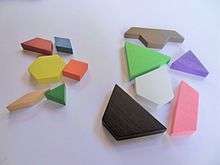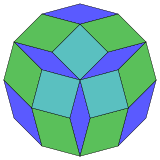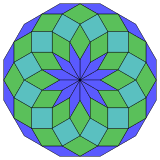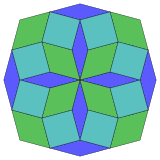Pattern Blocks
Pattern Blocks are one of the mathematical manipulatives developed in the 1960s by Education Development Center as part of their Elementary Science Study project.[1] They allow children to see how shapes can be decomposed into other shapes, and introduce children to ideas of tilings. The Pattern Blocks includes multiple copies of six shapes:
- Equilateral triangle (Green)
- 60° rhombus (2 triangles) (Blue) that can be matched with two of the green triangles
- 30° Narrow rhombus (Beige) with the same side-length as the green triangle
- Trapezoid (half hexagon or 3 triangles) (Red) that can be matched with three of the green triangles
- Regular Hexagon (6 triangles) (Yellow) that can be matched with six of the green triangles
- Square (Orange) with the same side-length as the green triangle
All the angles are multiples of 30° (1/12 of a circle): 30° (1×), 60° (2×), 90° (3×), 120° (4×), and 150° (5×).
Pattern Blocks are used for creative design—"floor" tiling patterns; pictures of animals, flowers, boats, rockets, and so on—and for mathematical purposes other than geometric (e.g., introducing ideas of fractions and proportionality).
An example of their use is given by Meha Agrawal: "Starting from the center, I would add tier after tier of blocks to build my pattern — it was an iterative process, because if something didn't look aesthetically appealing or fit correctly, it would require peeling off a layer and reevaluating ways to fix it. The best part was the gratification I received when my creation was complete. Though individually boring, collectively these blocks produced an intricate masterpiece that brought art and math, big-picture and detail, simplicity and complexity closer together".[2]

A number of compatible shapes that extend pattern blocks are commercially available. Two sets of "Fractional Pattern Blocks" exist: both with two blocks.[3] The first has a pink double hexagon and a black chevron equivalent to four triangles. The second has a brown half-trapezoid and a pink half-triangle. Another set, Deci-Blocks, is made up of six shapes, equivalent to four, five, seven, eight, nine and ten triangles respectively.
Examples
| Regular dodecagons | Isotoxal octagon | ||
|---|---|---|---|
 |
 |
 | |
References
- ↑ Picciotto Math Education
- ↑ McFarland, Matt (9 December 2013). "The childhood toys that inspired female engineers and scientists". The Washington Post. Retrieved 10 December 2013.
- ↑ "Spark: Math Manipulatives". www.ucds.org.
External links
- Pattern Block Templates: Printable Worksheets for Pattern Blocks
- Flash Pattern Blocks for web and Mandalar for mobile devices (iOS/Android).
- ETA/Cuisenaire: Educational manipulatives & supplemental materials for grades PreK-12.
- Background on the Elementary Science Study
- Educational and supplemental materials for K-12
- Secondary school activities using pattern blocks